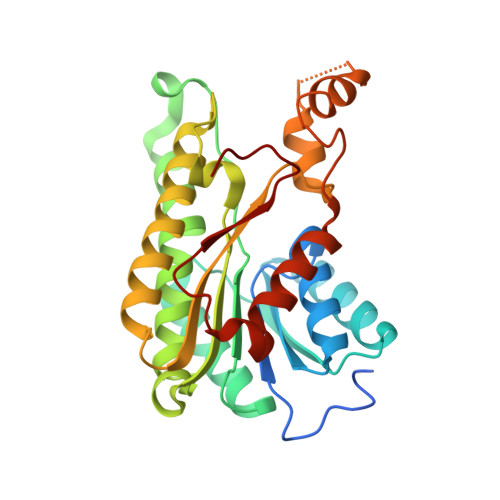Structural and Biochemical Analyses of Regio- and Stereospecificities Observed in a Type II Polyketide Ketoreductase.
Javidpour, P., Korman, T.P., Shakya, G., Tsai, S.C.(2011) Biochemistry 50: 4638-4649
- PubMed: 21506596
- DOI: https://doi.org/10.1021/bi200335f
- Primary Citation of Related Structures:
3QRW, 3RI3 - PubMed Abstract:
Type II polyketides include antibiotics such as tetracycline and chemotherapeutics such as daunorubicin. Type II polyketides are biosynthesized by the type II polyketide synthase (PKS) that consists of 5-10 stand-alone domains. In many type II PKSs, the type II ketoreductase (KR) specifically reduces the C9-carbonyl group. How the type II KR achieves such a high regiospecificity and the nature of stereospecificity are not well understood. Sequence alignment of KRs led to a hypothesis that a well-conserved 94-XGG-96 motif may be involved in controlling the stereochemistry. The stereospecificity of single-, double-, and triple-mutant combinations of P94L, G95D, and G96D were analyzed in vitro and in vivo for the actinorhodin KR (actKR). The P94L mutation is sufficient to change the stereospecificity of actKR. Binary and ternary crystal structures of both wild-type and P94L actKR were determined. Together with assay results, docking simulations, and cocrystal structures, a model for stereochemical control is presented herein that elucidates how type II polyketides are introduced into the substrate pocket such that the C9-carbonyl can be reduced with high regio- and stereospecificities. The molecular features of actKR important for regio- and stereospecificities can potentially be applied in biosynthesizing new polyketides via protein engineering that rationally controls polyketide keto reduction.
Organizational Affiliation:
Department of Molecular Biology and Biochemistry, University of California-Irvine, CA 92697, USA.
















